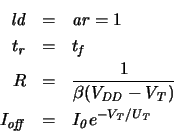



Next: D.4 Simple Adiabatic Techniques
Up: D. Energy Recovery
Previous: D.2 Adiabatic CMOS
Returning to Fig. D.2 with real MOSFETs as switches it
becomes clear that the finitely large subthreshold leakage not only
contributes to the switching energy but also changes the asymptotic
behavior.
Assuming, for simplicity,
we can write an equation for the switching energy in an adiabatic
CMOS circuit:
 |
(D.2) |
This means that for a fixed threshold voltage the switching energy has a finite minimum value.
Further analysis shows that for minimum
 ,
where
,
where
 ,
the
switching energy and rise time are related to the supply voltage as
,
the
switching energy and rise time are related to the supply voltage as
which means that the scalability of adiabatic CMOS is limited
not only by the overhead required to compensate for the performance
loss but also by the maximum affordable supply voltage.




Next: D.4 Simple Adiabatic Techniques
Up: D. Energy Recovery
Previous: D.2 Adiabatic CMOS
G. Schrom



